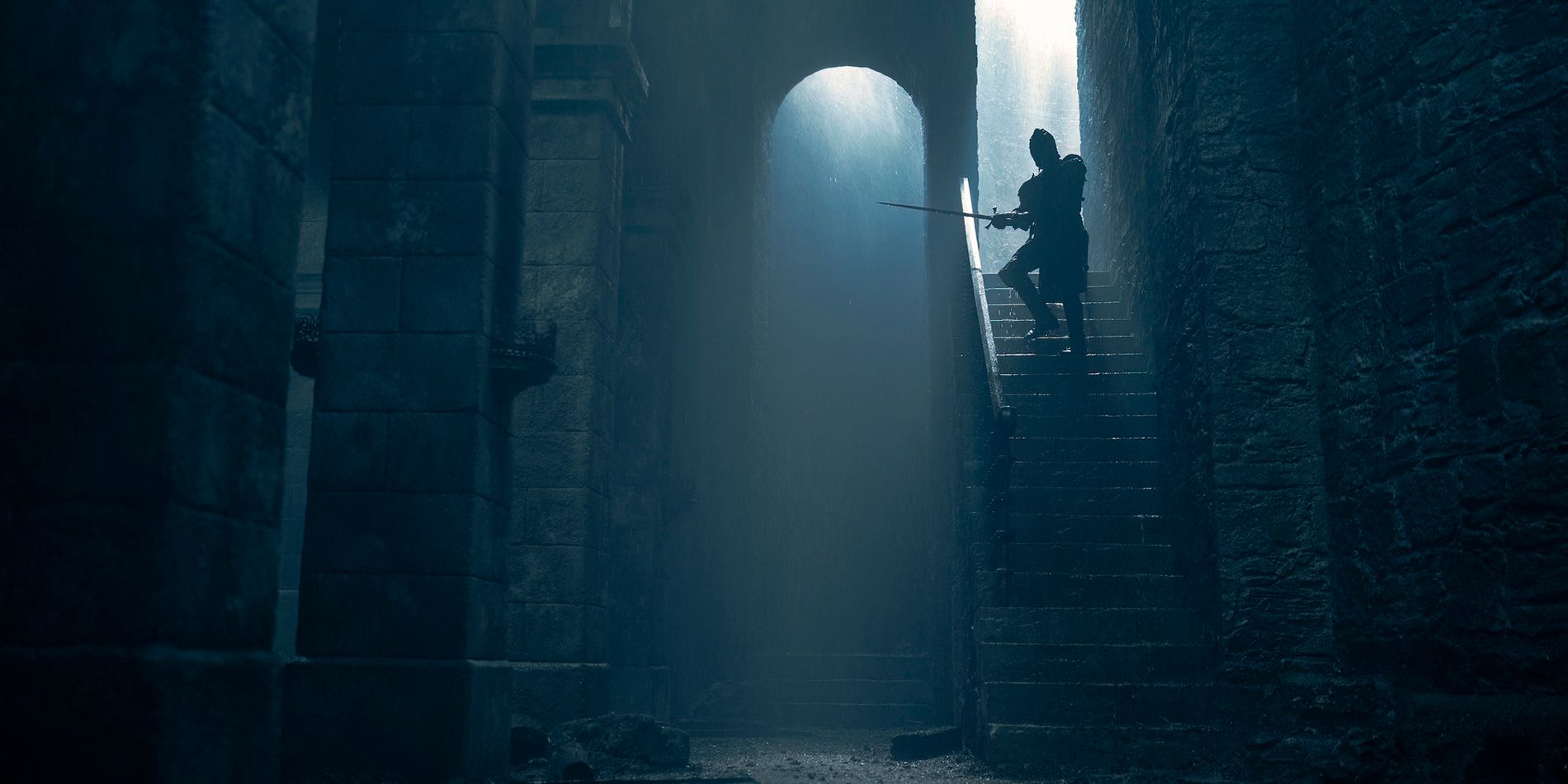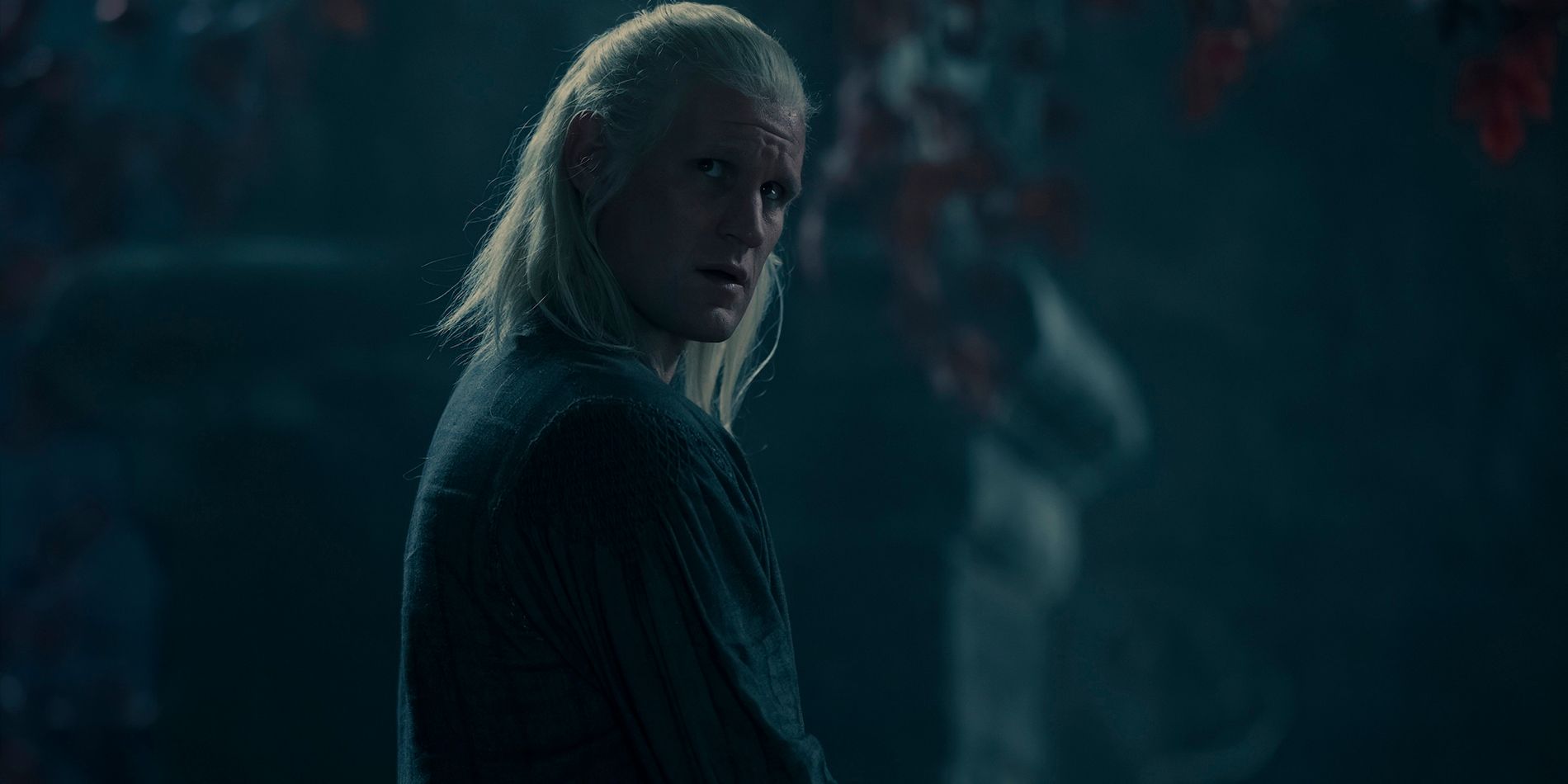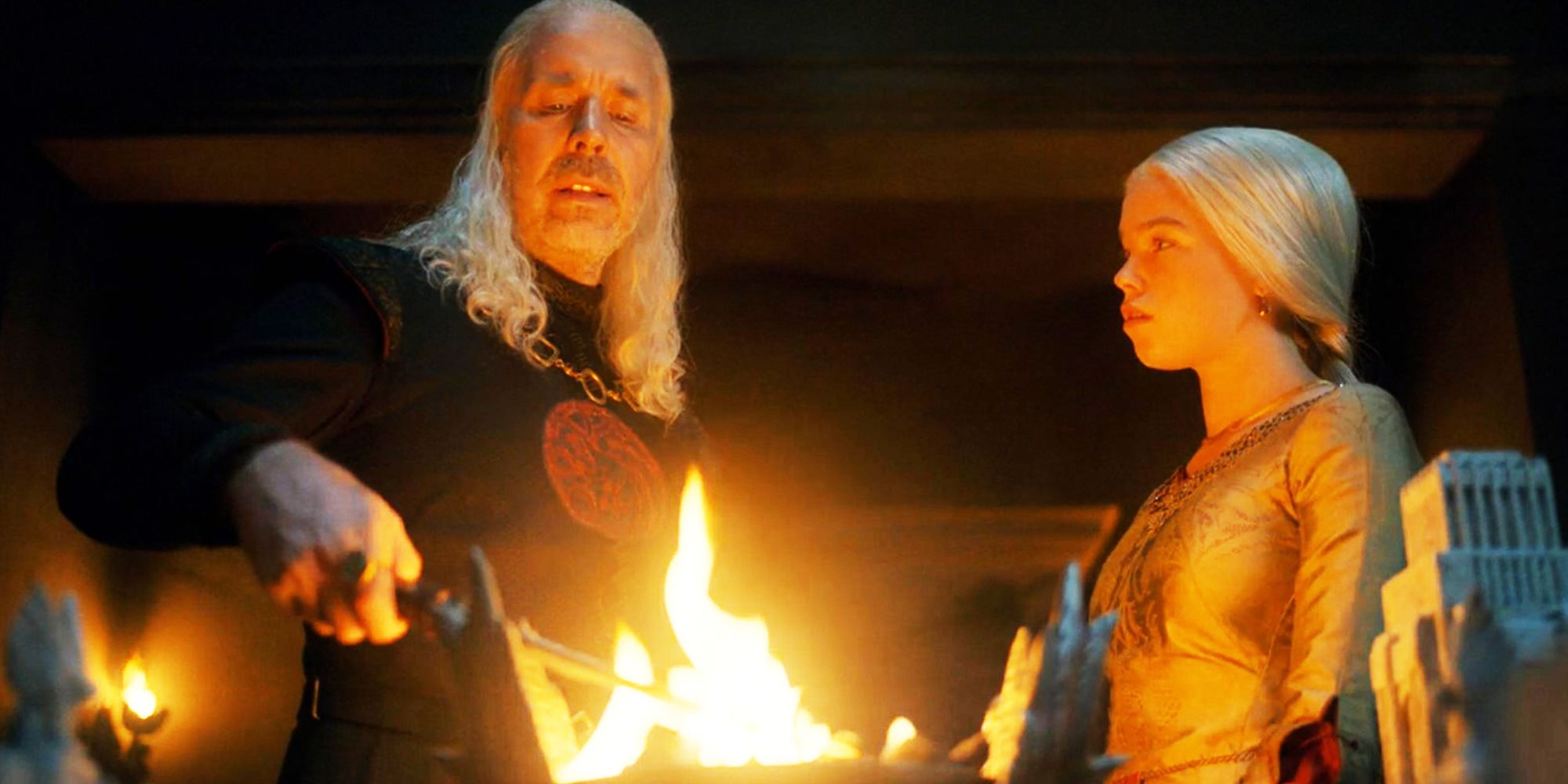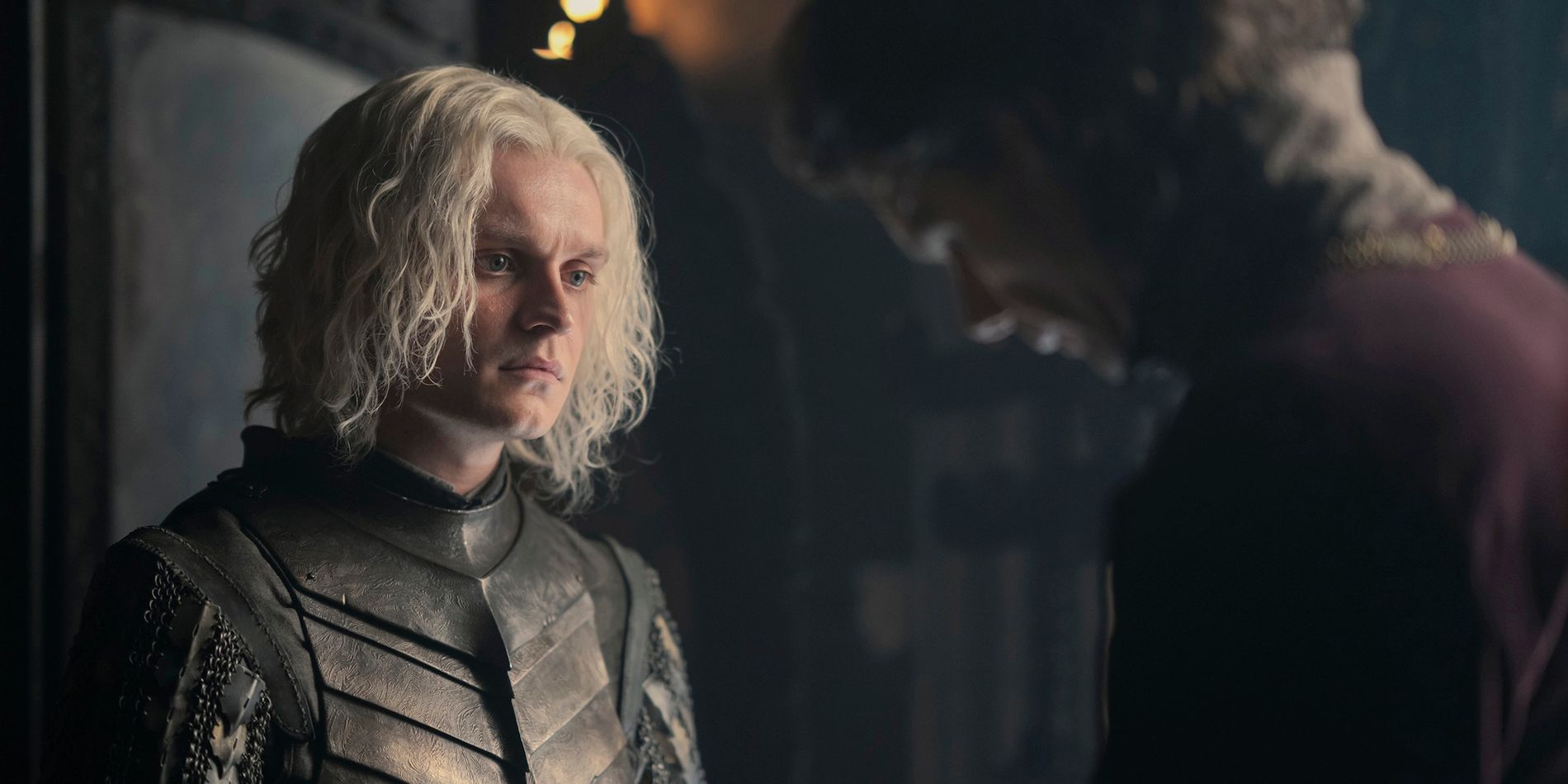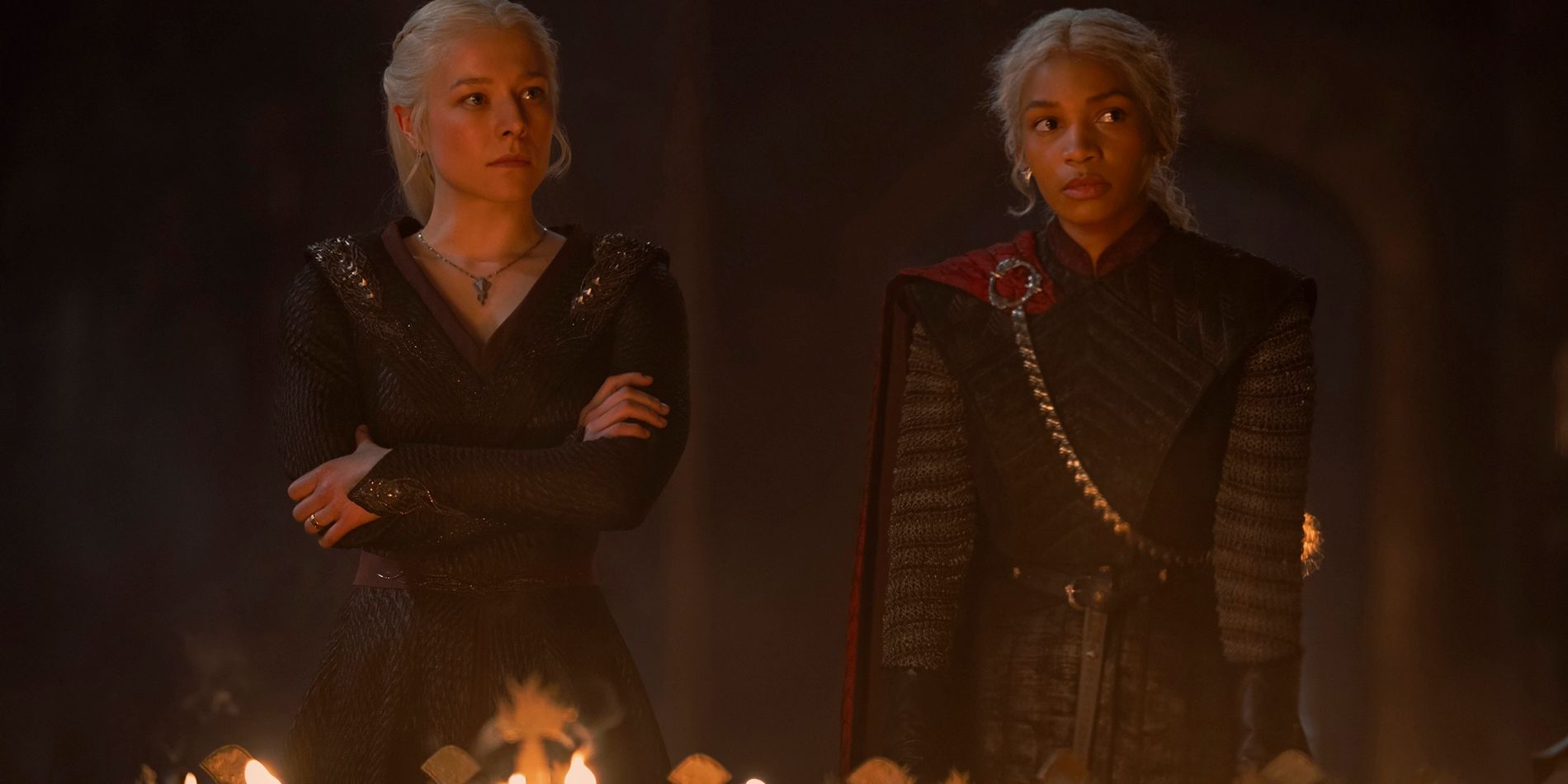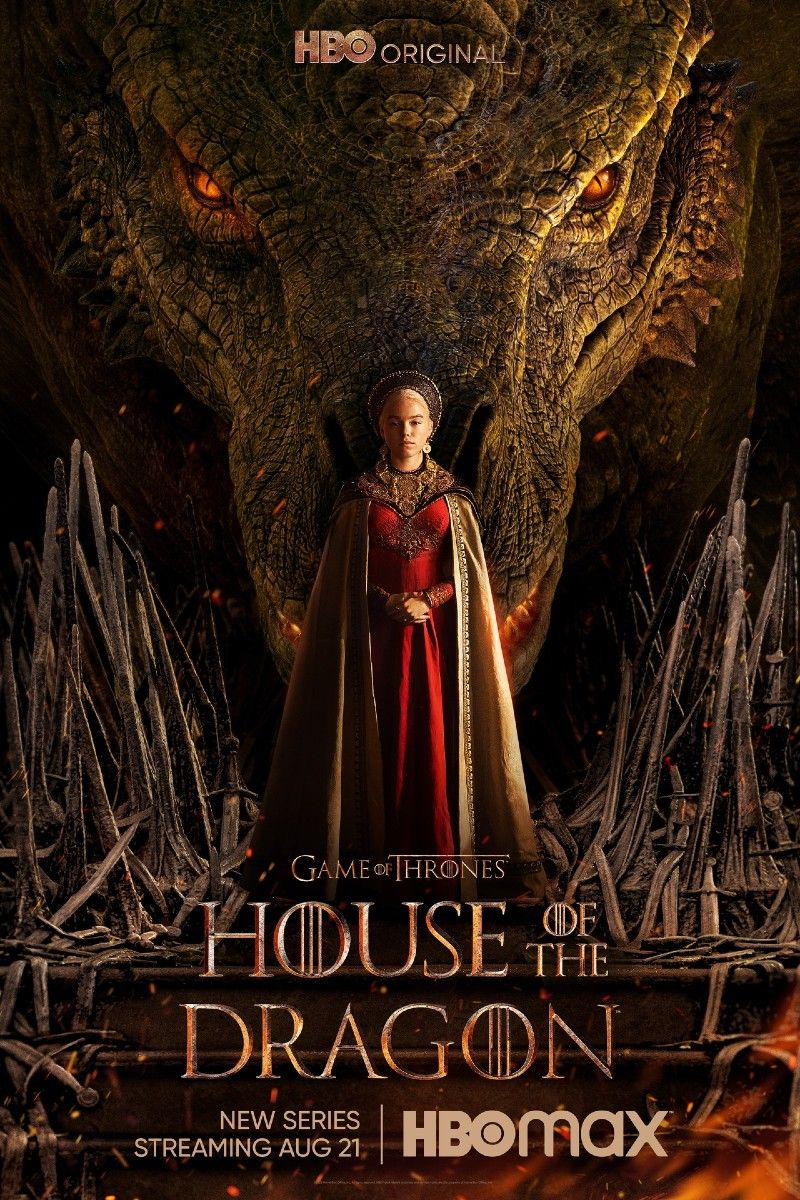Warning: SPOILERS for House of the Dragon season 2, episode 3!
Summary
- Director Geeta Vasant Patel discusses her approach to
House of the Dragon
season 2, episode 3. - Patel shares insights into the development of Daemon’s arrival to Harrenhal, Rhaenyra’s critical reunion, and Baela and Moondancer’s scenes.
- She also emphasizes the importance of improvisation and balancing fan expectations with storytelling.
House of the Dragon season 2, episode 3 is full of shocking surprises and callbacks to both the previous season and Game of Thrones itself. Daemon Targaryen has left for the Riverlands after a no-holds-barred fight with his wife Rhaenyra, and his quest to take Harrenhall gives viewers a deep look at his psyche even as it unlocks an important piece of Westeros lore. Rhaenyra, meanwhile, confronts Alicent face-to-face for the first time since her father’s death, and the resulting meeting has important implications for both the secret her father Viserys shared with her and the inevitable war to come.
House of the Dragon‘s latest episode was directed by Geeta Vasant Patel, who has previously helmed episodes of Under the Bridge, The Great, and Ahsoka, proving her emotional intelligence and extraordinary vision regardless of the genre in question. She already took part in House of the Dragon, directing the critical season 1 episode “The Lord of the Tides”, and her work on the show highlights the significance of the interpersonal relationships at the heart of the war between kin.
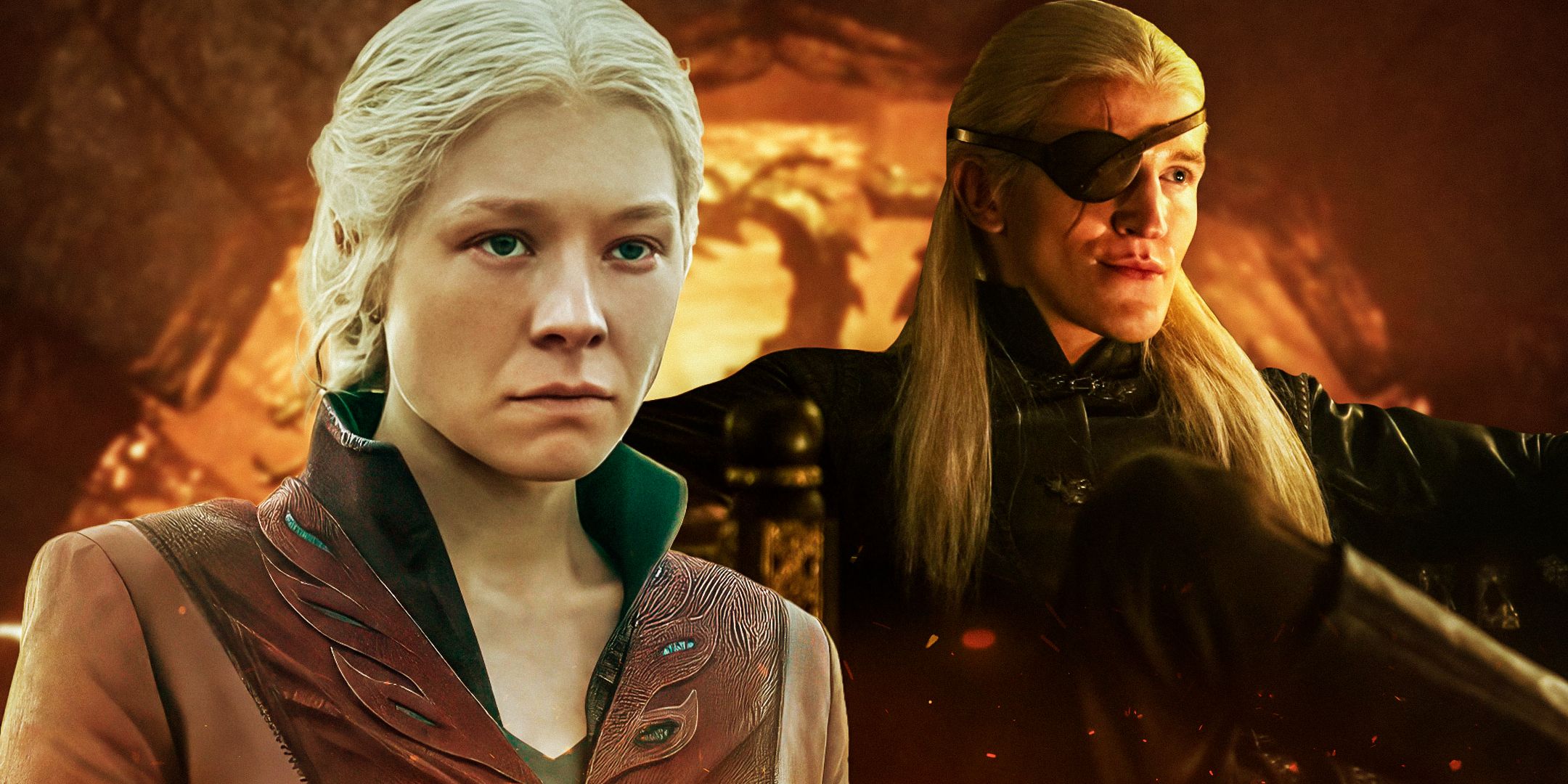
Related
When The House Of The Dragon Season 2 Finale Releases & How Many Episodes There Are
Following its premiere episode on June 16, the House of the Dragon season 2 finale will mark an epic event in the summer 2024 TV slate.
Screen Rant interviewed Patel about her approach to House of the Dragon season 2, episode 3. Patel revealed plenty of details about how the events of the latest episode affect Daemon, Rhaenyra, Alicent, and Baela. She also explained how reading the scripts for the season as a whole helped her lay the groundwork for moments that will pay off in a big way down the line — especially as she also directed the season 2 finale.
Harrenhal Reflects Daemon’s State Of Mind In House Of The Dragon Season 2
Screen Rant: You direct an episode early this season, and you also direct the finale of season 2. How much do you know of the end when you’re working on the beginning? Do you get a big picture when you’re working on moments, such as the introduction of Alys Rivers? Do you know where that’s going?
Geeta Vasant Patel: One of the things I love about working on the show is the scripts are done before we start, so I was able to read the ending. I had all the episodes before I started working, and I personally don’t understand why we don’t do that more. I appreciate and respect HBO and Ryan Condal for pushing for that because, at the end of the day, it’s a story.
The entire season to me is a film, and when we look at film, we look at the three-act structure and the first act and the third act need to mirror each other. There needs to be a setup. The first act has the setup, and the third act has the payoff — visually, performance-wise, and story-wise. A lot of times they say, “Write your ending before you write your beginning.” It’s so difficult to for me just have an episode and not know where it’s going and what it’s setting up, even if it’s the middle of the season.
Everything was incredibly intentional, and knowing the end very much influenced what we did as a team for episode 3, because there is a lot of setup in that episode that pays off all the way through the episodes that lead to [season 2, episode 8].
This episode is really the first time that we get a look at Harrenhal when it’s not in flames. What are the challenges of portraying Harrenhal and making it feel unique compared to the other castles we’ve seen, as well as creating that haunting atmosphere?
Geeta Vasant Patel: It was definitely a team effort. Jim Clay is our production designer, and he was so great at grounding the design of Harrenhal. None of us wanted the show to be fantasy; that’s not the tone of the show, so we’re always making sure that it isn’t too unbelievable that it looks like a place that actually does exist somewhere. That’s Jim Clay, and that’s the special effects team with the dripping water and all of the rigs that we had in that set.
Then the visual effects team takes a step further. We sat down and started thinking, “Okay, Daemon’s coming down the stairs. There’s a wall here, but in post, let’s open up that wall and make it a corridor. But let’s not make that wall open because we don’t want it to be too big.” It’s been a huge work in progress throughout the season, creating Harrenhal.
One thing also that was really important was to make sure that Harrenhal was confusing and disorienting, so it would be large in places and then tight in places and go up and go down. That was something we were constantly checking ourselves on; just that it was a metaphor for what was going on inside Daemon’s head. He was in a space he’d never been before. I read the scene and thought, “There’s something really missing for me. I feel like there’s something more we can do with this scene that’s not on the page.” Matt [Smith] and I started talking, and he felt the same way. “This is a great scene, but there’s something else. It’s not about Harrenhal.”
I finally woke up one morning and realized, “Wait a minute, it’s about Daemon’s relationship with Rhaenyra. It’s about Daemon and where he just came from.” This is not an isolated scene because, if it’s just him arriving in Harrenhal, you can put it anywhere at any time. But what’s important is that Daemon gave his heart to Rhaenyra. He married her when he’s not a marrying kind of guy. He doesn’t let anyone in, but he let her in. And she, in episode 2, pushed him away and told him he was dirt; he was ugly. That hit him like a bullet, and he doesn’t take bullets.
The way he processes pain is anger, so I went back through the scene with Catherine [Katie] Goldschmidt, who’s our brilliant cinematographer, and Jason Rickwood, our AD. We all kind of sat down and went through line-by-line with this in my head. The first thing is the dragon goes through the air, and we had a concept — but forget that. Daemon is a guy who just broke up with his wife. She’s called him every name you could think of, and he’s drinking; he’s angry. He wants to cut somebody, or maybe he wants to cut himself. He’s done. He’s wasted, and the dragon’s wasted, so we called it the “Drunken Dragon” scene, and we worked with visual effects to create the movement and the ambiance so that it feels like it is that kind of night. He’s drunk and driving through a storm.
And then when he’s in Harrenhal, it’s the same thing. Matt and I talked about how he just came from being pushed away by the one person he let in. He’s embarrassed; he’s hurt. He told himself he would never let himself feel this again. As he’s going through the hallways, it’s not about, “What’s going to come around the corner?” It’s, “I don’t know where I am anymore on the map. I don’t know who I am anymore. I hate myself. I hate my life. I hate that she did this to me. I want to kill her.” Just all this madness that we’ve all been through. And then there’s a guy down the hallway, and it’s scripted that the guard sees him and then runs away. Matt did it, then he came up to me and goes, “I just want to beat the hell out of that guy.” And I said, “Okay, I want you to.” He said, “That’s me. That’s Daemon.” We didn’t have a lot of time as usual, so we did it the way it was scripted, but then we did it this way as well. And it wasn’t just, “Beat the guy up.” It was, “Feel everything you want to feel. Where you came from.” He just kept going, and that’s what made the cut in the end.
Those are the things I think are the next step when a script goes to the directors and actors. We know what the story is that the writers have entrusted us with, but what’s great about the show is they don’t write exposition. They write story, and they allow the actors and the directors to bring the exposition into the spaces. I loved that about season 1. In episode 8 [which I directed], you never see Alicent and Rhaenyra saying, “I miss you. I’m thinking of you right now.” We had to figure out a way to make that happen, and it’s really fun.
Milly Alcock’s Appearance Reveals This Significant Truth About Daemon & Rhaenyra’s Relationship
Daemon actually sees Rhaenyra in this episode, but it’s Milly Alcock. Is the intentionality behind her appearance that this is when she looked up to him, rather than looked down on him?
Geeta Vasant Patel: You’re absolutely right. At least in my eyes, that’s what it was. “That’s the Rhaenyra I know.” And in that dream, she looks at him — and the way we talked about it is she doesn’t need to say anything. We just worked on the look; the meaning that comes from all the episodes before she looks at him, and she cuts him. She says, “Hey, you killed a boy. You don’t do that.”
People have said that to him all the way through. But when young Rhaenyra says it to him, it’s the first time he feels it. It’s the first time he processes his actions, though he’s been killing people left and right since the beginning. This is the first time we see him regret. We see him feel. We actually kept talking, in between takes, about how this is something we’ve never seen before in Daemon.
There was a take where Matt went in, and he just kept saying, “No, I need another take. I need another take.” He was really such a hardworking actor on this, and all of a sudden I saw his face break after Milly looked at him. I just saw his hands loosen, and I saw the tear in his eye. Then I had a tear in my eye because we both felt it. Even the crew got emotional at that moment. And it wasn’t about House of the Dragon, it was about making a mistake that you deeply regret that hurt somebody else. It’s just that simple. That’s what I love about working on this show. I like to think that it is a documentary with dragons. We always try to make it feel real; like something we can relate to.
Aegon’s Dream Is About Rhaenyra & Alicent’s Egos More Than It Is About The Fate Of Westeros
Rhaenyra and Alicent reuniting onscreen is a huge moment for the story. How did you and the actors approach a moment with so much weight behind it? How do you achieve the right balance of dormant affection and active fear?
Geeta Vasant Patel: When the two women came together at the end of this episode, we just felt like, “Wait a minute, this isn’t about stopping the war. This is about these two women and their relationship. This is about Rhaenyra’s relationship with her father.” And so, we stopped for a minute and walked through episode 8 from last season, which we had all worked together on.
In episode 8, these two women had been fighting, fighting, fighting, and then finally promised each other that they would be friends. And Alicent tells Rhaenyra, “You are the queen.” This is the first time they’re coming back around and seeing each other face-to-face, and it is a reckoning for both of them. Alicent saw what she saw, and Rhaenyra feels betrayed by her sister.
The other thing that we realized was that, again, Rhaenyra is not there to make a deal. Why is she really there? In my mind, and this is what Emma [D’Arcy] and I talked about, she’s there because her dad walked down that aisle in episode 8 and told her, “I love you, and I choose you.” He had not chosen her before; nobody had chosen Rhaenyra. That was a big moment for her, and now everything that happened is thrown away because apparently he said, “No, no, I take that back. It’s not her. It’s this other guy.”
Rhaenyra was there to ask, “Did my father love me? Did he lie to me?” And that’s what that moment’s about. That’s where, in the scene, you’ll see that’s where Rhaenyra is most emotional. And that’s where I think we did most of the work in that scene as a team.
The other thing about that scene that wasn’t clear to me until we started shooting how Rhaenyra came in to stop the war and confront Alicent to be like, “Hey, we can stop this.” Alicent’s like, “Okay, what are you going to give me? How are we going to compromise?” And Rhaenyra is like, “Well, no, I have nothing to compromise on.” You realize that there is going to be a war because neither of them is willing to compromise. I think there’s something really profound that’s happening with Rhaenyra, because she is someone who in the past has compromised. But in this moment, I believe — and this is me as a fan — there’s an ego rising in her.
When we shot the scene where she says goodbye to her kids earlier, and in order to connect the tissue of this ego rising, Katie and I had this arcing shot at the very end of that scene. You see Rhaenyra say goodbye to her kids, and everyone knows that moment of saying goodbye to someone you love, but then the camera arcs around, and the light changes. We had the sun setting, and you see a shift on her face where everything becomes solid and steel. There is an ego forming, and I think that really helps develop the end of the episode where you feel the ego again. Alicent is spinning from everything she’s just heard, but her ego keeps her from saying, “Okay, you’re right. I’m wrong.” Instead, she’s just like, “No, I’m sticking to my guns,” so Rhaenyra’s galvanized to push the button.
How much importance would you say should be placed on Aegon’s dream here? Are there bigger implications for the season, and for the franchise as it expands, or is it more about Rhaenyra as ruler vs. the current Aegon in the show?
Geeta Vasant Patel: In my opinion, it is a means to an end. I think in this season, it’s about characters’ fate. The things that have happened before episode 3 have informed the trajectory from episode 3 to episode 8. It’s not Aegon’s dream that’s motivating everyone. It’s just accommodating their egos.
Despite Not Showing The Battle Of The Burning Mill, House Of The Dragon Highlights The Horrors Of War
This episode had the Battle of the Burning Mill, but it happened mostly off-screen. Was that always the case? Was that a story-driven, “let’s keep the powder dry for bigger battles” decision, or was that budgetary?
Geeta Vasant Patel: You’d have to ask HBO and Ryan. I actually never asked that question, but it’s an interesting one. I love shooting action because I’ve worked in a war zone, so this is something that feels very familiar. I love movement and choreography, so when I read the scene, I was like, “Nooo!” I couldn’t believe I didn’t get the action here.
But then I read it again, and I loved it. I felt the challenge of what I needed to deliver as director, and what we needed as cinematographers, actors — everybody as a team. Because in that scene, you have two boys, and you don’t even know them. We’ve never introduced them in the show. They have a conversation, and then we cut to everyone dead. So, you have to actually experience the battle that you didn’t get to see. It has to feel like something you’ve experienced before.
So, I sat down with the two young actors, and we talked about the fact that this is something they actually can feel very easily if they bring it home. I told each of them to think of the person they love the most and imagine if the other [actor] brutally killed that person. We took a minute and immediately rehearsed the scene, and how they acted in that scene is pretty much what you see at the opening of this episode. Because that’s why wars go on; that is unfortunately the “eye for an eye, and the whole world is dead” of it all. Anyone who says, “Why can’t they just stop fighting?” doesn’t understand the guts of these situations.
You said this show is a documentary with Dragons to you, which makes me think that your approach to the realism of Under the Bridge must be similar to your approach in House of the Dragon. What is your North Star as a director to make sure that you’re authentic in the emotions brought forth?
Geeta Vasant Patel: When I started directing, I worked for a screenwriter who did production rewrites, so we worked on big-budget films like The Fast and the Furious and Blue Crush. I’ve always been someone who’s independent-minded, and it was really good for me because I understood Aristotle’s three-act structure and why storytelling works when someone just sits down and is like, “Let me tell you a joke. Let me tell you a story.” That is a really hard thing to do, and I think working in commercial storytelling allowed me to understand the basics.
Then I made a documentary [Meet The Patels] with my family, particularly my brother who is a comedian. I had never worked with actors before, but my brother, Ravi, is my North Star. He is a beautiful actor, a beautiful comedian, and what makes his work so beautiful is that he improvises and finds it within himself. He doesn’t project performance, he finds it from within. Working with him is how I knew I wanted to work with actors. There are miracles always happening.
What I bring to everything I do, particularly in genre, is try to just break it down to real life. And the way I do it is a lot of improvisation. People say, “I don’t improvise,” but I don’t believe it. It’s like when people say, “I don’t dance.” Everybody can dance, just like they can improvise, because it’s just who you are. If they bring who they are to each line, each character, and each story, that’s their best work. People can argue with me on this, but I feel that the greatest actors I’ve worked with, that’s what they do.
House of the Dragon’s Holistic Approach To The Season Led To Minor But Important Changes for Baela
From a fan perspective, Rhaena is sent to the Vale with dragon eggs and even told to go to Pentos. Naturally, fans have already speculated that we will see Daenerys’ dragon eggs in the series. Do you approach scenes like that with Game of Thrones show callbacks in mind, if not the actual speculations themselves?
Geeta Vasant Patel: I am a fan, and so is Catherine Goldschmidt. We both have had those moments. We’ll be like, “Oh my God, it’s the eggs!” But it’s funny because, and we’re all fans in the crew, so it’s really a fun job because a bunch of fans are making the show.
But then we’re pretty much like, “I need to do my job, and it’s always about the story.” Then it’s just a matter of, “Do I really need to see the eggs? How long do I need to see them? What is this really about?” Because otherwise, we’re just going into this direction where we’re heavy on exposition. So, it’s a fleeting, wonderful moment, and I pinch myself every time. I remember when I saw the eggs, I was like, “I can’t believe my dream came true, and I’m working on this show.” I wanted to work on the show for years and had worked very hard to try to get even an interview on the show, so it’s not lost on me that I was given this opportunity and now continue to work on it.
This episode is the closest and longest look we’ve gotten at Baela and Moondancer and how they fly together. How much input did you have there?
Geeta Vasant Patel: Ryan is an extraordinary showrunner, and he really charges us with challenging the script and making everything as great as he wants it to be. When I read the script, I always send this long list of my notes, and one of the biggest notes I had was, “I don’t understand why the scene is here with Baela chasing these guys down. I just don’t get it. If I take it out, everything’s still fine.” It bothered me, so then Ryan took it out, and I was like, “Whoa, I didn’t mean to take it out. I mean, let’s make it make sense.” It was really funny.
We sat down with the writers. It was myself, Katie, Jason Rickwood, and then the writer of the episode, David Hancock. We asked David, “What is this supposed to tell us? What is this supposed to be?” And we realized that it is there, but we just need to push it up. One of the things that I felt very strongly about is that, in order to care about the scene, you have to care about Baela. And we’ve never known her; we didn’t know who she was.
We needed to introduce Baela here, but as usual, we had to do it without words. That’s what we do on this show; we don’t do exposition, so the bar is very high. I sat down with the actors who played Baela and Rhaena, and we did this improvisation exercise for a very long time where they both had to go back to who they were as kids. I pitched them the idea that Rhaena always straight straight A’s but never got a dragon, while Baela has never done anything right and has always been an iconoclast, and she got a dragon. That’s not fair.
Then they started building their characters and how they were as kids, and we all started pitching ideas to the writer. We started really crafting with the writers and the producers, and it was a wonderful war room of all of us crafting the layers of Baela and Rhaena that we needed to make them human and to have them each have this pivotal dramatic pain in their childhood. I won’t tell you what it is, but they both built it. When we got to Baela on that dragon, it wasn’t about, “I’m on a dragon, and I see these guys below.” It was about more than that.
Ryan and the writers’ team really took it to heart as far as introducing Baela, and they went across the entire season adding another layer of her; just little finesses. And so did Bethany [Antonia], the actor who plays Baela; we were all working together. She also started chiming in, “Well, this is what I think I would do here.”
The biggest thing we need to do for this scene to stay in the script is set up and pay off, so we made it more clear that Rhaenyra says, “Go check this out, but don’t get close.” We tried to drive that home, so when she gets close and breaks the rules, she’s Maverick. Then she reports back and says, “My God, you guys, I saw them. They’re going into the woods.” Rhaenyra’s like, “Wait a second. How’d you see them? And she goes, “Well, I just went in close.” We needed that sentence to have a beginning, middle, and end there.
All these things are just such a fun part of when the directors and actors come on, because these guys have slaving away to make all the magic, and then we come in and go, “But what about…?” And it’s literally all there, but you’re just trying to lift it off the page.
About House of the Dragon Season 2
Based on George R.R. Martin’s “Fire & Blood,” the series, set 200 years before the events of “Game of Thrones,” tells the story of House Targaryen.
Check out our roundtable interviews with the cast and creators of House of the Dragon season 2 as well.
New episodes of
House of the Dragon
air Sundays at 6pm PT/9pm ET on HBO.
